Gift ideas for a photography loving parent
Father Christmas approved!
It's that time of the year when we search for ideas to buy for our nearest and dearest or items to add to our personal 'Dear Santa I've been a very good girl/boy really'.
And we're here to help with BOTH! As a certified photography obsessive I scoured the world wide internets for things that are worthy of your wallet.
BUT FIRST
Before we dive into our list, let me just state for the record that one of the best gifts you can offer to someone interested in photography and capturing their kids beautifully would be something that will help them actually learn how to do it - aka learn how to use that camera and take dramatically better photos - that's what we excel at! Whether you want to learn the basics of photography, elevate it to another level or explore Photoshop or Flash - we've got you!
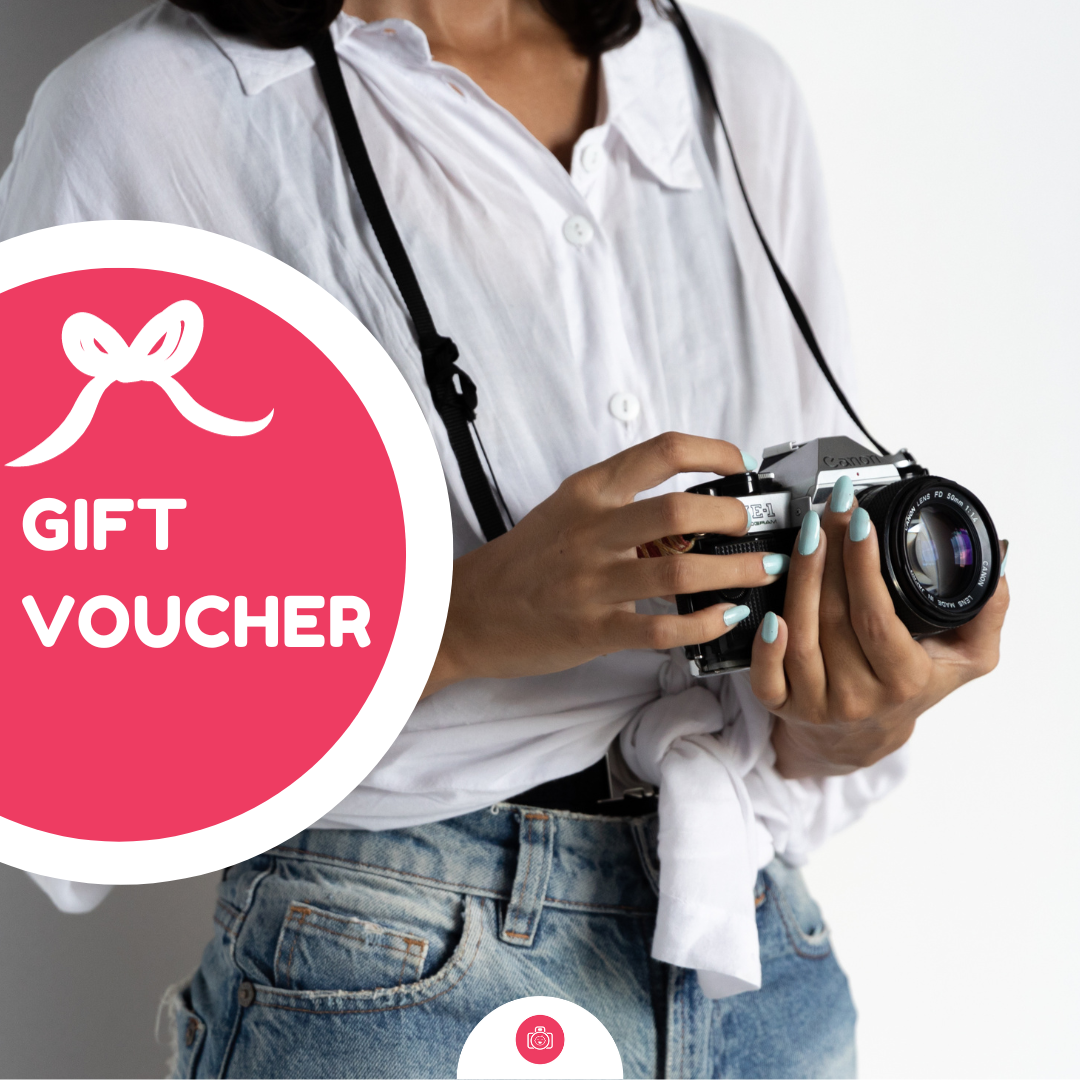
Gifts for a PhotograpHER
IMPORTANT - this is most emphatically NOT an affiliate post, we have NOT received NOR asked for any payment for the recommendations or other form of reward, they stem ONLY from our own experiences and items which are popular in our community. With exception of our own products ( PFP courses, vouchers and merchandise) we have no vested financial interest in all other recommendations at all!
To make it easier to navigate this mammouth selection we broke it down into browsable categories - just click on each one to be taken to the right section. Or just scroll on to view the whole list!
Boring essentials
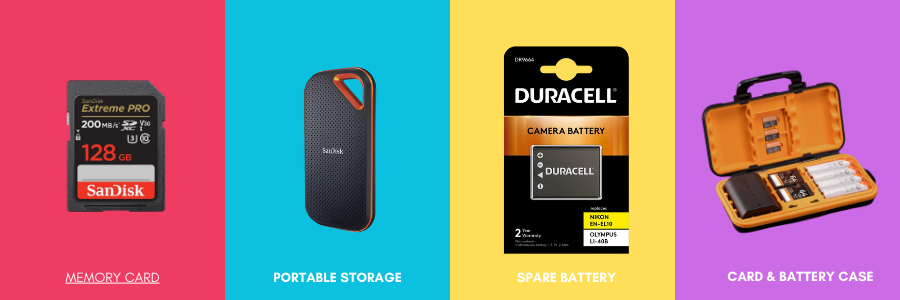
Memory cards
There is not a single photographer who would refuse a gift of a memory card or 3. Maybe it's not the most exciting of gifts, but it will get A LOT of use. Plus those things can break or corrupt - never not be prepared! Important - not all memory cards are created equal. Aim for those with a high Memory card speed ( 104MB/s as a minimum, preferably higher) - this is about how fast the memory cards can record the images. SanDisc Extreme Pro are a great, reliable brand - highly recommended! currently £16.99 on Amazon for a 64GB card
Portable Hard drives
In the same vein - those many many photos of your kids are quick to clog up even the roomiest of hard drives. It's best to keep them on separate hard drives ( PLUS BACKUPS - you're all backing up, right???) and my fave are those sleek little workhorses also from Sandisc - sleek, resistant to drop and moisture with
Spare batteries
A spare battery and charger ( maybe one that you can plug in a car?) will also always be welcome by any photographer. It's one of those things that you don't think about until you find yourself with a dead battery in the perfect photo moment. Now the question - branded or unbranded? There are lots of third party battery makers for all cameras, and the quality is, well, variable. But there are also big brands or well established brands which produce replacement batteries that are cheaper than originals - Duracell is one of them. They might not hold the charge quite as long as the branded alternatives, but they are not far off - just make sure that you get one that's made for your specific camera make AND model
Memory card holder
Once you have your spare batteries and card, it would be a good idea to have something to keep them safely in. You could invest in separate memory card holder but there are cases that will allow you to safely hold your spare batteries and card in one padded, portable package - we like this one from K&F concept - although there are few other brands available so pick the one that suits your needs better. K&F concept Card & Camera Battery Case - £11.99 at Amazon
Carrying your camera

By default, the straps our cameras come with are pretty poor. They tend to be too narrow to hold the weight comfortably without digging into our necks, every time you bend they swing forward and frankly there are so many great alternative options, I never ever bother with mine. My preferred way to carry a camera with a cross body strap or either strapped to my hand with a clutch hold.
Shoulder or hand strap?
My personal favorite brand in camera straps is Peak design - they are comfortable to wear, look sleek and the design is thoughtful and practical. I particularly love the fact they use a fast dismount system ( comprising of little button-like attachments you add to your camera, that are easy to disconnect from the strap ) which is interchangeable between different types of straps. I switch between my cross body strap and and hand clutch in 2 sec flat because they both use the same type of fastening. Other manufacturers have begun using a similar approach - I spotted Vanguard and K&F both having a version of those. Check out the Peak design range at Wex although they are carried by multiple retailers so it's worth looking for the best price on your chosen design
More padding?
If you would like something a bit more padded I like the RuPac sentinel - it sat securely on my shoulder without sliding all over the place. There are plenty of similar alternatives available from various brands in lots colours and styles so shop around if you want more options. I would just pay attention to the fastening system as that's often the weak link in the cheap brands and I've had some fail on me completely.
Hands free
And if you don't like having your camera hanging on your side or dangling from your hand, you could try a camera clip. It's a plate which attaches to either your belt or a backpack strap and which holds your camera using a metal plate that screws onto your camera base. It's a hands free solution that will work great for smaller cameras in situations where you want your hands free.
Keeping your lenses safe
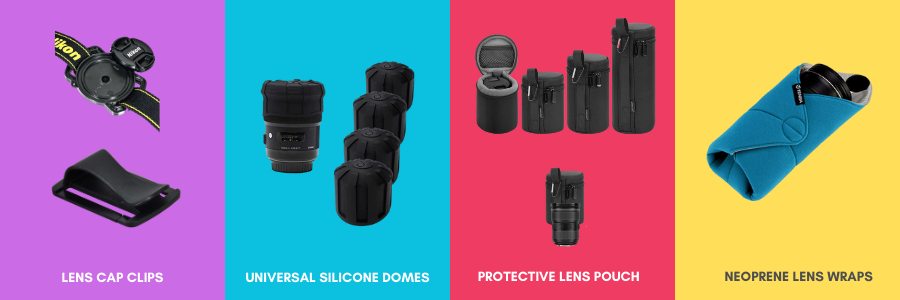
I can't even count the amount of lens caps I have lost over the years. I believe they are in the same land that has all my lost single socks and all those things I carefully put away in a 'safe but easy to find place' that will never be seen again.
Lens Cap Clips
And if you have the same problem, a little £3 buckle may be the answer - it's a little buckle you could thread onto the camera strap, that allows you to clip your lens cap onto it when not in use. They come in a few sizes so make sure you get one that will suit the majority of your lenses. If you want something even more versatile, this simple alternative clip which costs £2 may just be the ticket.
Universal Lens Covers
If you want to just fully replace your protection for the lens, you could switch to Universal Silicone Covers which get pulled onto your lens like a little sock. I personally think there are some of the best things I've bought for my lenses.
Protective Lens pouches and wraps
If you carry your spare lenses around you definitely want to invest in something that will keep them safe from accidental knocks and dust. One optio is to get some padded protective lens pouches - they come in various designs - from rigid zipped tubes to softer drawstring pouches. Depending on how you plan to use them one version may be more appropriate for you than the other - the rigid tubes will withstand more knocks but you will usually need to get sizes specific to your lenses, whereas the softer pouches can be more universal.
An alternative approach is to use more flexible neoprene protective wraps that can be wrapped around your delicate items, that will keep them a safe from dust and any (gentle) knocks.
Set the camera down: Tripods
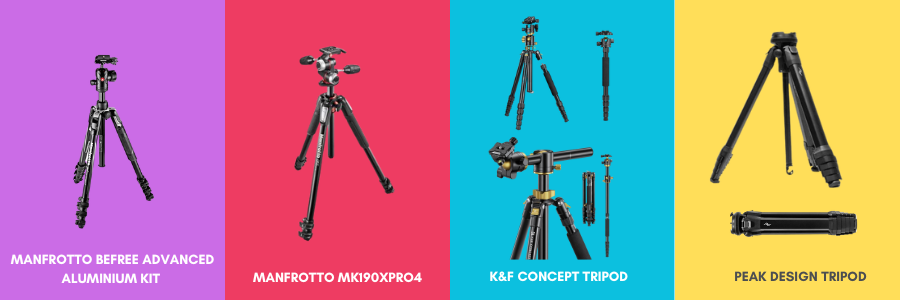
A good tripod will last you a long time and be of use in lots of different situations - from low light or long exposure shots to helping you get into the frame. But with the eleventy zillion tripods on sale at vastly different price points, narrowing down your choices takes a little digging.
Get one that's too light and it won't keep your heavier camera safe. Get one that's too heavy and you won't want to take it with you anywhere. Small and compact - potentially too short for what you'll need and so on and so forth. Cheap and cheerful? Poor built makes it fall apart. So we've done the research so you don't have to and here are our best recommendations for the enthusiast photographer who wants a good balance between price / sturdiness and portability and whose gear isn't hugely heavy.
Just a couple of caveats - there are lots and lots tripods out there that are good enough that would suit most casual photographers needs - I picked some options from among many similar ones because they had an outstanding feature that others didn't or the built vs price vs current offer were just nudging them ahead of others.
Secondly, just be aware of the fact that if you buy a tripod for a particular manufacturer, you will usually be able to have a choice of different heads - from simplest screw head that simply screws onto your camera, to ball-heads with or without quick release plates, swivel plates with or without levers and so on. So if you find that the tripod you have fits you in all ways other than the head - you can usually upgrade those to something better.
Here are our recommendations:
Manfrotto Befree Advanced Aluminium Kit - well balanced, good build and from a company that's the gold standard in tripod manufacturing. It weighs just 1.5kg and is capable of holding up to about 8kg of weight ( although I probably wouldn't push it quite to the limit) . It extends to 1.5m. By default it comes with a ball head with a quick release plate. If you can spend a little more - Manfrotto MK190XPRO4 Tripod would be my choice for a sturdier, taller, more robust but still portable tripod. This one comes with a 3 way lever control head which I personally find easier for precise positioning.
Need something more flexible that can do lots of different angles? This versatile design from K&F concept may be what you're looking for. It is designed to cater for lots of different needs - it can convert from a traditional tripod to a monopod or lock legs in multiple positions and switch the center rod to a horisontal, turnable position for those overhead shots or panoramas. It can go very low to the ground or extend up to 1.7m, It weighs only 1.7kg so is still very portable
If your money can stretch a little further, look at Peak Design Travel Tripod - Peak design gear isn't cheap, but it's always beautifully designed and carries a lifetime guarantee so this may be the only tripod you will ever need to purchase - and for once it's on sale!. Super compact, very intuitive in operation ( fast release and secure legs, ball head and quick release plate) , weighs in at 1.5kg and extends to 1.5m in height. Comes either in aluminium or carbon fiber option ( more pricy). Peak design tripods are almost never on sale so if you were pondering on this - now is your time to act.
And if you want something super portable to to place your camera on but don't need height? I take my Joby gorilla pod with me a lot - it just is such an easy and versatile little kit that you can stand up or attach to lots of things and keep your camera nice and steady. They come in a few different weight options so pick one that will keep your heaviest gear steady.
Shooting accessories : filters

If you've never had a chance to play with creative lens filters, maybe it's time to ask Santa for some - they can open new photo opportunities and make shooting more fun. They range from more functional to creative and both are worth owning.
First let's talk about types of functional lens filters available out there :
UV filters - these are used to block ultraviolet light, helping to reduce haze and blue cast in photographs, especially in outdoor and high-altitude settings. Many photographers use them as an extra layer of scratch protection in front of their expensive lenses and while their efficacy in doing so is disputed, if you are to get one, make sure it's a good quality glass one rather than a cheap plastic / resin one. No point spending lots of money on expensive lenses only to dull them with cheap filters...
Polarising Filters - Polarizing filters are used to reduce reflections and glare from surfaces, enhance the color saturation and contrast of the sky and clouds,. They help make images shot in strong light appear more saturated and richer with fewer hot spots.
Neutral Density filters ( ND filters) - Neutral density filters for camera lenses are like sunglasses for your lens and are used to reduce the amount of light entering the lens, allowing for longer exposure times or wider apertures in bright conditions, useful for achieving motion blur effects. They come in various strengths ( depending on how much light they filter out). Personally if I was to get a ND filter I would get one that blocks at least 6 light stops ( ND64 ) or 8 ( ND256 ). There are also variable ND filters which consist of two panes of glass with a twist mechanism but personally I don't tend to recommend them as the higher you go, the more risk you have of showing some distortion and while they tend to go 2EV stops to around 8-10 EV stops, you usually only end up using the more higher values anyway at which point you are better off just getting an 8 stop or a 10 stop fixed value filter.
If you want a starter set, K&F concept has great filter sets that clip on / off with a magnetic attachment.
The important thing to know about all of these filters is that they screw onto the lens you have so you need to know what lens diameter you have ( or if you have lenses with multiple, what lens are you likely to use that filter on the most). You can quickly check your lens diameter by looking on the front edge of your lens - it will typically tell you the lens size next to a symbol of crossed out 0. Alternatively, you could invest in an adapter set like this one from k&F concept which will allow you to put larger filters on smaller lenses ( I wouldn't recommend going the other way)
Shooting accessories : creative toys
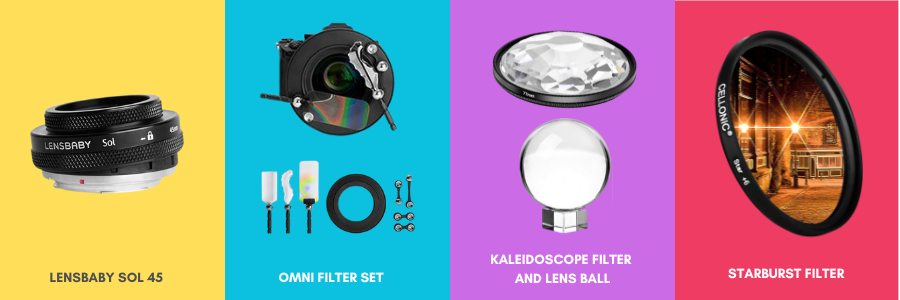
Toys can help break you out of your photography rut and open new creative possibilities. We've round up a few things that could do just that!
Funky tilt shift lens
Top of the list is Lensbaby - a creative lens that allows you to be creative with sharpness and blur in your image - is designed to create a sharp central area of focus surrounded by a dramatic and smooth blur - you can actually shift the focus plane, giving photographers creative control over the orientation and size of the in-focus area. This effect helps in drawing attention to the subject by isolating it from the background. While there are multiple types of Lensbabies, our very own Kate Ainger who is a Lensbaby ambassador recommends starting with Lensbaby Sol 45mm which is more affordable and easier to learn. If you were eying one of those beauties up, there is currently 30% off on most Lensbaby products on Wex with the code LB-30
Creative Filter set
Another option from Lensbaby - but one that can be used on any other lens - is the Lensbaby OMNI Creative Filter System - it consists of a ring that gets screwed onto your lens onto which you can add a variety of light bending accessories so that you can precisely angle your creative effects. If you want more colour or texture, you can additionally get several Expansion packs which comes with various wands, filters, colour gels, rainbow diffraction filters and more. They are designed to fit onto the Omni ring, but can also be handheld separately if you don't want to spring for the original set.
Crystal balls and Prisms
Not keen on spending a lot on a set f filters if you're not sure that you will used them a lot? You could dip a toe in the creative filter water by purchasing standalone crystals / kaleidoscope / prisms - These need to be held near the lens to refract and bend the light and help create creative effects. Here are a few of our faves: Crystal Ball ( for creating an inverted image inside the ball) , Kaleidoscope filter ( for multiplying parts of the image, Starburst filter ( for shaping lights like starbursts)
Clean lenses! - Cleaning accessories
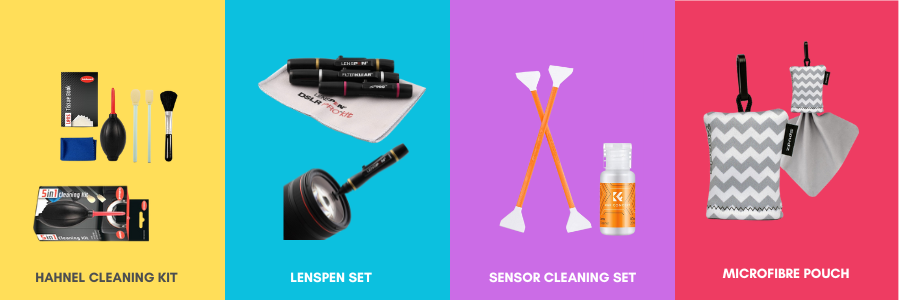
How do you keep your lenses clean and mark free? This cleaning kit from Hahnel or this Lenspen set have you covered. Both come with high density brushes and blowers that help you dislodge stubborn dust particles safely, the Zeiss set also comes with a cleaning liquid and microfibre cloths. But if you have a mirrorless camera and you've been seeing marks appearing consistently in your images, you may want to give your camera sensor a clean too. And while this may seem like a nerve wracking proposition, with the right tools it's actually really easy. All you need is a microfibre swab and a couple of drops of lens cleaning liquid - I have used this set from K&F multiple times and it's worked really well. Lastly, for cleaning on the go, this handy detachable pouch with an enclosed microfibre cloth which you can just hook onto your bag will give you a quick way to wipe your lenses clean while keeping them safe from scratched or smudges.
What to do with your images? - editing software and accessories
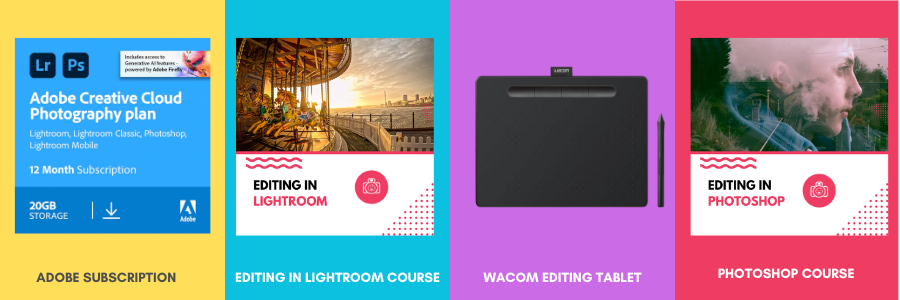
I've said it before, and I'll have it engraved on my tombstone - Editing is a completely essential skill for any photographer - whether you're just editing your kids birthday photos or anything more. And there is arguably no better software for it than the Adobe Photography suite including Lightroom and Photoshop. You normally get these on subscription for around £10/m but a 12 month pre-paid Adobe Photography Plan subscription option including Lightroom, Lightroom Classic AND Photoshop is now on sale at just £68 for a year's worth of subscription via Amazon . For anyone with an active subscription directly from Adobe, you can just 'stack' this 12 month product on with your regular subscription payments pausing for a year.
Don't know where to start with Editing - once you snagged that Adobe subscription>>> sign yourself up to our Editing in Lightroom course- currently on sale with our Black Friday Sale. We will teach you everything you need to know about the tools, science and art of editing in Adobe Lightroom so that your photos really start to shine. This is where you learn how to save those over / under exposed photos, how to make the colours pop, how to selectively edit parts of your images, how to even know where to start when opening your photo in an editing suite.
Already into editing? Let Santa make your life easier with these 2 gadgets. Anyone who does a lot of editing, quickly learns that a mouse or a trackpad is not the most ergonomic or intuitive way to do it. This is where an editing tablet with a pressure sensitive pen comes in. Wacom is the world leader in making those and you really don't need one that's got all the bells and whistles. This Wacom Intuos is a great starter option, especially if you already have a decent monitor. If you want something with a display to look at rather than your screen, this Wacom One Pen Display is a great option.
And if you want to push your editing skills into a whole new realm, Photoshop is where you want to be - join our incredibly detailed, meticulously explained 2-level Photoshop course ( currently on sale at the best price we've ever done for it!) and learn how to find your way around it, how to use the key tools within it and how to get creative so that your photos can become ANYTHING you want.
And if you started editing with Photoshop but struggle to remember all the key keyboard shortcuts - try on this Photoshop Shortcut skin for your keyboard that will help you bring them
What to do with your images? Display your photos
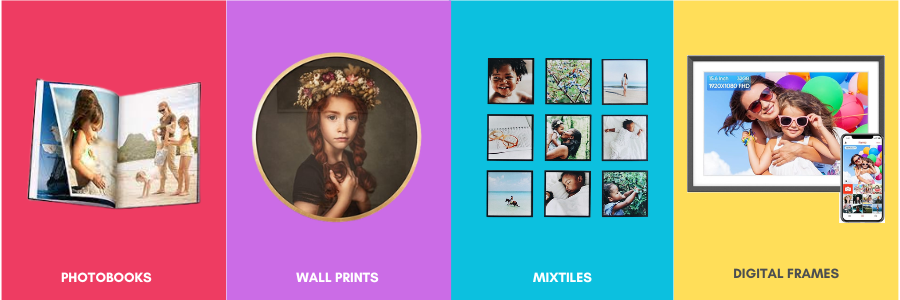
Photo books
Don't let your beautiful photos languish on your computer or phone only! You should be proudly displaying them for all to see - especially the people you captured! Seeing themselves in the photos can help with kids reluctance to be in front of the camera - something actually tangible they can see for all the times they've had a camera in their face. A photo book is a great way of organising and featuring your favourite memories and right about now almost all the photo book companies are having a sale. We like Colorland and Photobox for your standard family books ( that will get thumbed and smudged from much leafing. Cewe, Saal and Blurb are higher quality options that are worth saving for those extra special photos or as a beautiful gift for a loved one.
Photo printing
If you want to fill your walls with your photos, it's worth spending a little more on quality finish and paper - if you want your colours to be true to life and the finish professional, invest in professional printing services - it's not as expensive as you might think and will make a world of difference. We love Print Foundry, Whitewall and The Print Space for superbe, gallery like quality prints.
Ready to hang photo tiles
If you're after a more whimsical or relaxed display, you might like Mixtiles- or Hellocanvas - order your prints directly from an app and they arrive printed on times ready to be put directly into a wall. There are a few similar companies which offer variations of those so shop around for what suits you best.
Smart digital frame
Finally, if you don't want to limit yourself to seeing a handful of images only, you could invest in a great digital frame. And I know we all got scarred by those rubbish digital frames of 10 years ago - with tiny screen, poor contrast and resolution and dull colours. Well, I'm here to tell you that a new generation of digital fames is here and it's not messing about. One of the things I love about them is that they can be connected to your phone or a dedicated email and fed photos directly from your devices - this is particularly great as a gift for grandparents who will always love new images of their grandbabies appearing on their walls.
Aura is a brand of digital frames that consistently gets great reviews for its ease of operation, connectivity, variety of sizes and and the quality of display. Depending on the model it can offer more customisation options and photo storage so it's worth browsing through the range to see what might suit you best.
And if you want something larger and have more pennies to spare Meural from Netgear is an absolutely brilliant display - large, bright and looking like a gallery print on your wall. It comes with a dedicated app that can be fed from multiple accounts and the quality is outstanding. My parents have one and every time I visit I'm blown away by how great it looks. My one grumble is that it only offers a 16:9 aspect ratio ( like an oversized phone screen) so photos taken in other size ratios get cropped. Museframe is an alternative brand here which offers more size options ( though at a similar price point)
As an alternative - if you already have photos in the cloud - either on google photos or amazon photos, you can use theor smart devices ( Amazon echo and Google Nest hub to display your photo galleries. The screen resolution will not be quite the same quality but it's still a viable option if you want to combine your photo viewing with the devices smart functionality. Amazon Echo show 15 smart display is a great choice here, especially somewhere where it's bound to be used for its other functionality such as video streaming or internet connectivity ( perhaps as a Kitchen screen?)
Explore a different shooting style: macro, film, action!
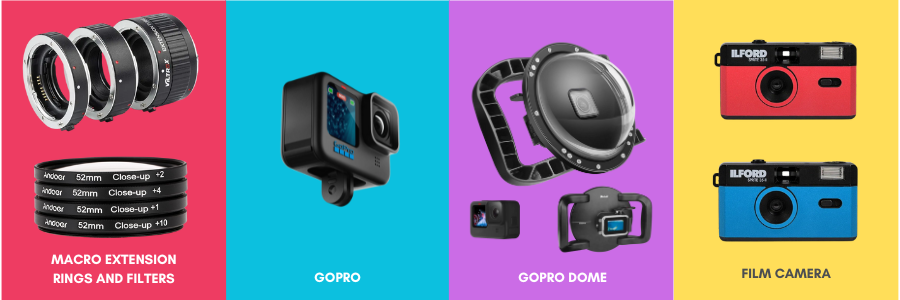
Try Macro!
You may not know it, but macro photography is not really possible with a regular lens - it simply cannot focus so close as to take a macro type photo. UNLESS you get yourself some Macro Extension Tubes. What are those you might ask? They create an extra space between your camera and your lens, which allows your lens to focus at a shorter distance than it otherwise would have - much cheaper option to get started with Macro photography than getting a dedicated macro lens. Make sure you go for an option that allows Auto focus ( AF) and steer clear of the cheapest options which are often poor built quality and can even get stuck on your lens or camera. JJC , Vitrox and Meike are decent budget options - just make sure you get one for your camera make and mount.
Another way to go is to place the magnifying element at the front of the lens using Macro filters like this one . Macro filters, also known as close-up lenses or diopters, are lens attachments that allow a camera lens to focus closer than its normal minimum focusing distance. Unlike extension tubes, they are screwed on the front of the lens ( so it's important that when you pick one you get one for the right lens thread size ( like all other lens filters). Macro filters are rated in diopters (+1, +2, +4, +10, etc.), which indicate their magnifying power. Higher numbers provide greater magnification.
Action photography
Fancy something ultra portable, waterproof, shock proof and uncomplicated to use? - Gopro or other action camera may be what you're after. These little beauties are fabulous for showcasing your family's adventure as and although primarily set up for video, they can produce fantastic still images as well ( my personal favourite feature is the ability to pluck still frames from recorded video via their dedicated app - thus ensuring you can always get the 'money shot' and never miss the timing. Gopro Hero 12 is the latest version of the camera but there is very little that separates it from previous model (Hero 11) so if you want to save some money and aren't huge on video recording - I'd opt for that one.
Gopros come with a lot of accessories but my favourite by far, if you plan on using it in the water is a gopro dome - this clever thing allows you to capture those split level ( half in water / half below) images you may have seen all over t'internets. They come in different versions but my favourite is the two handle one - it's easy to see the gopro screen and easy to trigger the photos - with one or two hands. Just make sure you get one for your specific gopro model - the size of gopros varies just very slightly and the dome casing needs to fit snuggly around it and if you get the wrong type you may find that it won't fit.
Try Film photography!
I know I know we're all about the digital now - and there are plenty of great reasons why! - but as someone who learned on film, I still get nostalgic about it. If you've never tried it, getting yourself an inexpensive analog camera and taking it for a spin may be a fun way to explore photography. Ilford Sprite 35 is a little film camera that is super simple to use with a wide angle fixed lens and if you like what it does, you could always move on to one of the many vintage analog cameras available through second hand sellers. Since so few people shoot with them now, they can be found at great prices
A gift of more light: flash, LED and accessories
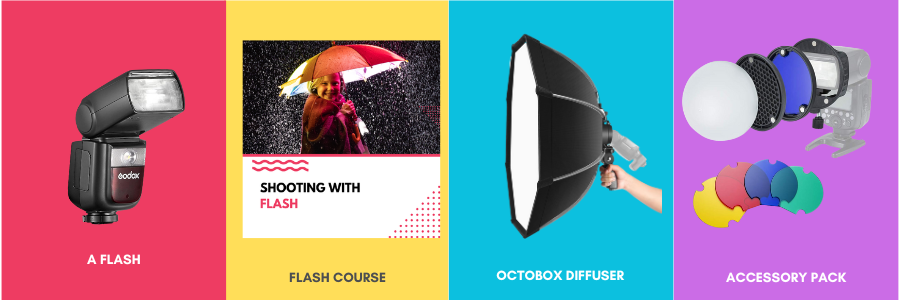
Winter is coming. Low light photography is going to be the main type of photography we will all be doing. But what if you could get some extra light to play with?
But what do you need equipment wise? The choices are dizzying and options complex ( and we have a long blog that goes over those in detail) but in general you will be needing a flashgun that's compatible with your camera and a remote controller that will allow you to take it off camera and place anywhere you want. And although there are lots of options out there, Godox is a brand that makes flashes and accessories for pretty much all camera makes and is both reliable and doesn't break a bank. For a compact flash, great for Mirrorless cameras, try Godox tt350, for a full size, fully-featured option, go for Godox V860III or if you can push the budget a bit further Godox V1. All these flashguns will work with the Godox XT2 or Godox Xpro controller. Just make sure you get one that's made for your camera brand!
Then you need to learn how to actually use it - this is where we can help - our very own Shooting with Flash course will take you from flash novice to being able to use it on and off camera to both supplement your natural light and to get creative with it. I do not exaggerate when I say it unlocks a whole different door in your photography skillset.
And if you want to make your flash more versatile - I highly recommend this accessory pack - it screws onto your flash ( it's adjustable for it will work with most full size flashes of any brand) and features magnetic accessories that include a diffuser dome ( for softening that light), grid ( for focusing the light) and colour gels ( for colouring the light). It's easy and fun to use and swap between attachments
And if you think about venturing into portrait photography and want something to soften that flash, this folding Octabox from Neewer is a great accessory for your flash.
For the photographer: odds and ends
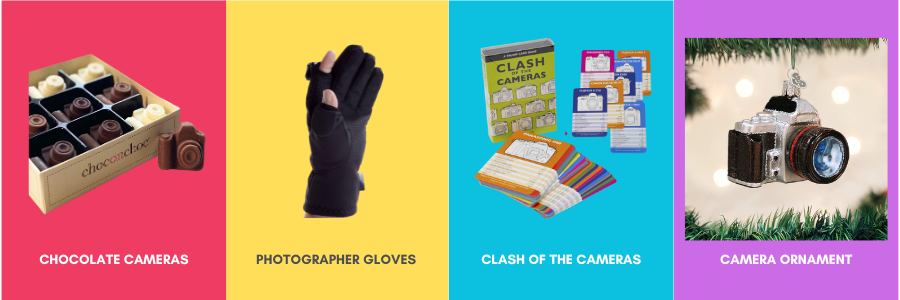
I want to round up this selection with a few odds and ends that will no doubt bring a smile to many photography enthusiast face, even if they don't neatly fall into a specific category. And so in no particular order
Camera shaped chocolates - enough said. Photographers need sustenance.
Photographer gloves - save your hands from freezing in the winter and still operate the fiddly buttons
Camera top trumps: for when you want to debate any camera's merits but also want to win
Camera Christmas Tree decoration - we all want one!
And lastly:
Did I mention our GIFT Vouchers???

